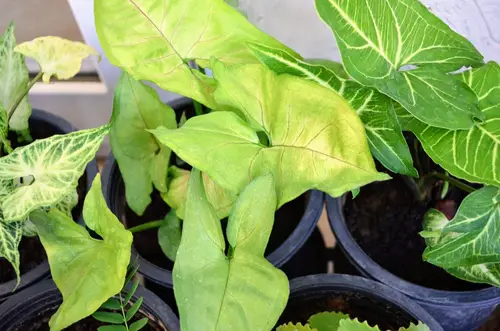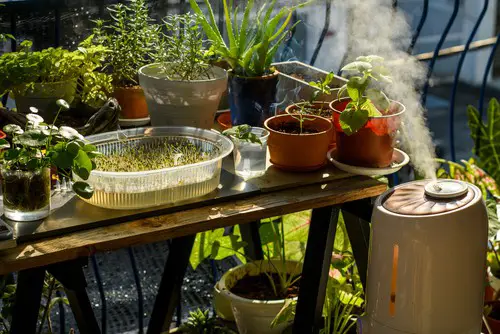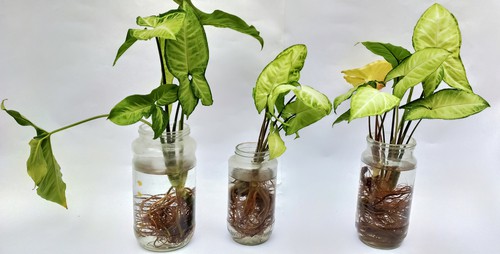Arrowhead plants are popular indoor houseplants known for their arrow-shaped leaves and easy-to-care-for nature. However, if you notice your arrowhead plant turning brown, it could be a sign of a problem.
Brown leaves can be caused by a variety of factors, including improper watering, lack of moisture, over-fertilizing, excessive light, leaf spots, pests, and fungi.
To understand why your arrowhead plant is turning brown, it’s important to know more about this plant. Arrowhead plants are tropical plants that thrive in warm climates with high humidity. They prefer bright, indirect light and moist soil. However, they are also sensitive to overwatering and can suffer from root rot if their soil is too wet.
If you want to keep your arrowhead plant healthy and prevent brown leaves, it’s essential to provide the right care. This includes watering your plant properly, ensuring it has enough moisture, providing the right amount of light, and avoiding over-fertilizing.
With a little attention and care, you can keep your arrowhead plant looking healthy and vibrant.
Key Takeaways
- Arrowhead plants are tropical plants that need warm climates and high humidity to thrive.
- Brown leaves on an arrowhead plant can be caused by a variety of factors, including improper watering, lack of moisture, over-fertilizing, excessive light, leaf spots, pests, and fungi.
- To keep your arrowhead plant healthy, it’s important to provide the right care, including proper watering, moisture, light, and fertilization.
Check out these other top posts:
- Philodendron Birkin White Leaves Turning Brown
- Perlite Turning Brown:
- Peperomia Leaves Turning Brown and Falling Off
Understanding Arrowhead Plant

Arrowhead plant, also known as Syngonium podophyllum, is a popular houseplant that belongs to the Araceae family. This plant is native to South America, but it is now widely cultivated and grown all over the world.
The arrowhead plant is a versatile and easy-to-care-for plant that comes in a variety of colors and shapes, making it a favorite among indoor plant enthusiasts.
The arrowhead plant is also known as arrowhead vine, African evergreen, and goosefoot plant. It is an evergreen plant that grows up to 3 feet tall and spreads out about 2 feet wide.
The plant has arrow-shaped leaves that are usually green, but some varieties have variegated leaves with white, pink, or yellow markings. Some of the popular arrowhead plant varieties include White Butterfly, Emerald Gem, Holly, Maria Allusion, Pink Allusion, Strawberry Cream, and Florida.
Arrowhead plants are relatively easy to care for, making them a great choice for beginners. They thrive in bright, indirect light, but can also tolerate low light conditions.
The plant prefers moist soil, so it is important to water it regularly, but be careful not to overwater as this can lead to root rot. The arrowhead plant also prefers high humidity, so it is recommended to mist the leaves regularly or place the plant in a humid environment.
Despite being easy to care for, arrowhead plants can still develop problems like any other houseplant. One of the most common issues is brown leaves. Brown leaves can be caused by a variety of factors, including low moisture, excess heat, and natural aging.
When the plant gets low humidity and water, they experience dehydration, which can cause the leaves to turn brown. It is important to identify the cause of the problem and take corrective action to prevent further damage to the plant.
Why Is My Arrowhead Plant Turning Brown – 4 Common Problems
Arrowhead plants are known for their lush green foliage, but sometimes they can develop brown leaves, which can be a sign of a problem. In this section, we’ll discuss some of the common problems that can cause an arrowhead plant to turn brown and their causes.
1. Overwatering and Underwatering

Overwatering and underwatering are two of the most common problems that can cause an arrowhead plant to turn brown. Overwatering can cause the roots to rot, which can lead to brown leaves and even death of the plant. Underwatering, on the other hand, can cause dehydration, which can also lead to brown leaves.
To avoid overwatering, it’s important to make sure the soil is well-draining and to allow the top inch of soil to dry out before watering again. To avoid underwatering, it’s important to water the plant thoroughly and consistently, making sure the soil is evenly moist.
2. Low Humidity and Temperature
Arrowhead plants are tropical plants that thrive in high humidity and warm temperatures. Low humidity and temperature can cause the leaves to turn brown and even fall off. This is because the plant is not getting enough moisture and warmth to support healthy growth.
To increase humidity, you can place a humidifier near the plant or place a tray of water near the plant to create a humid microclimate. To increase temperature, you can move the plant to a warmer location or use a heat mat.
3. Improper Lighting
Arrowhead plants prefer bright, indirect light, but direct sunlight exposure can cause the leaves to turn brown and even burn. Low light, on the other hand, can cause the leaves to yellow and fall off.
To avoid improper lighting, it’s important to place the plant in a location with bright, filtered sunlight or in a shaded area. If the plant is not getting enough light, you can supplement with artificial light using a grow light.
4. Pests and Diseases
Arrowhead plants are susceptible to pests such as spider mites, scale, and mealybugs, which can cause the leaves to turn brown and even die. They are also susceptible to diseases such as leaf spot disease, which can cause brown spots and brown tips on the leaves.
To avoid pests and diseases, it’s important to inspect the plant regularly and treat any infestations or infections promptly. You can use insecticidal soap or neem oil to treat pests and fungicides to treat diseases.
Arrowhead Plant Care
Arrowhead plants are tropical plants that require proper care to thrive. Here are some tips on how to care for your arrowhead plant.
1. Watering and Soil
Arrowhead plants should be planted in well-draining soil. Make sure the pot has a drainage hole to prevent waterlogging. Water the plant when the top inch of soil is dry. Overwatering can lead to root rot, so make sure the soil is not too moist.
2. Temperature and Humidity Control

Arrowhead plants thrive in a humid environment. Keep them in a room with a humidifier or place them on a tray of pebbles and water. They prefer temperatures between 60°F to 85°F. Avoid exposing them to sudden temperature changes.
3. Lighting Requirements
Arrowhead plants prefer bright, indirect light. Direct sunlight can damage the leaves and cause them to turn brown. If the plant is not getting enough light, the leaves may become pale.
4. Pest and Disease Management
Arrowhead plants are low maintenance but can be susceptible to pests and diseases. Common pests include spider mites, mealybugs, and scale insects. Treat them with insecticidal soap or neem oil. Make sure to isolate the plant to prevent the spread of pests.
5. Pruning and Repotting
Prune the plant to maintain its shape and remove any yellow or brown leaves. Repot the plant every two years or when it outgrows its container. Use a fresh potting mix and make sure the new pot is slightly larger than the previous one.
Additional Tips for Healthy Arrowhead Plant
1. Use of Pebble Tray and Humidifier
Arrowhead plants thrive in a humid environment, and low humidity can cause brown leaves. One way to increase humidity is by using a pebble tray. Fill a tray with pebbles and water, and place the plant on top of the pebbles.
As the water evaporates, it will create a humid environment around the plant. Another option is to use a humidifier to maintain a consistent level of humidity.
2. Proper Watering Schedule
Proper watering is essential for the health of an arrowhead plant. Overwatering or underwatering can cause brown leaves. The general rule of thumb is to water the plant when the top inch of soil is dry.
However, the watering frequency may vary depending on factors such as the plant’s size, the pot’s size, and the humidity level. It’s important to check the soil’s moisture level before watering to avoid overwatering.
3. Avoiding Overfertilization

Overfertilization can cause brown leaves in arrowhead plants. It’s important to fertilize the plant only during the growing season and follow the instructions on the fertilizer package.
Too much fertilizer can lead to salt buildup in the soil, which can cause brown leaves. It’s also important to flush the soil occasionally to remove any excess salts.
4. Understanding Plant’s Dormancy Period
Arrowhead plants go through a dormant period during the winter months, and their growth slows down. During this time, the plant needs less water and fertilizer. It’s important to reduce watering and fertilizing during this period to avoid overwatering and overfertilization.
Conclusion
The arrowhead plant can turn brown due to various reasons such as low moisture, excess heat, improper watering, lack of moisture, over-fertilizing, excessive light, leaf spots, pests, and fungi.
To fix this issue, it is important to first identify the specific cause of the brown leaves. If it is due to low moisture, the plant needs to be watered adequately and kept in a humid environment. If the cause is excess heat, the plant needs to be moved to a cooler location.
If the plant is over-fertilized, it is important to reduce the amount of fertilizer and ensure that it is applied at the right time. In case of leaf spots, pests, and fungi, it is important to identify the specific issue and treat it accordingly.
It is important to note that the arrowhead plant is a tropical plant and requires a warm climate with high humidity to thrive. Therefore, it is essential to provide the plant with the right environment and care to prevent the leaves from turning brown.
Frequently Asked Questions
What causes brown spots on arrowhead plant leaves?
Brown spots on arrowhead plant leaves can be caused by several factors, including overwatering, underwatering, direct sunlight exposure, and fungal or bacterial infections. It is important to identify the root cause of the problem before taking any corrective measures.
How do I prevent arrowhead leaf spot disease?
Arrowhead leaf spot disease can be prevented by avoiding overwatering, improving air circulation around the plant, and keeping the leaves dry. It is also important to avoid overcrowding and to remove any infected leaves as soon as possible.
What are common problems with arrowhead plants?
Common problems with arrowhead plants include leaf browning, leaf spot disease, yellowing leaves, and root rot. These problems can be caused by overwatering, underwatering, direct sunlight exposure, and poor soil quality.
How can I revive an arrowhead plant with brown leaves?
To revive an arrowhead plant with brown leaves, it is important to identify the root cause of the problem and take corrective measures. This may include adjusting the watering schedule, improving air circulation, and removing any infected leaves.
In some cases, repotting the plant in fresh soil may also be necessary.
How often should I water my arrowhead plant?
Arrowhead plants should be watered when the top inch of soil feels dry to the touch. It is important to avoid overwatering, as this can lead to root rot and other problems.
Can arrowhead plants tolerate direct sunlight?
Arrowhead plants prefer bright, indirect light and can tolerate some direct sunlight. However, prolonged exposure to direct sunlight can cause sunburned leaves that turn brown and wither. It is important to place the plant in an area with indirect sunlight or filtered light.

Hey, I’m Lisa and I’ve been an avid gardener for over 30 years. I love writing, talking and living in the garden! Feel free to connect with me on my socials below


